|
ROADS, AND THOSE IN TRING
THE MOTOR AGE
|
“TRING. THE COMING VEHICLE
― On Sunday a motor car passing through the town came in for
a considerable share of attention.”
Bucks Herald,
12th November 1898 |
|
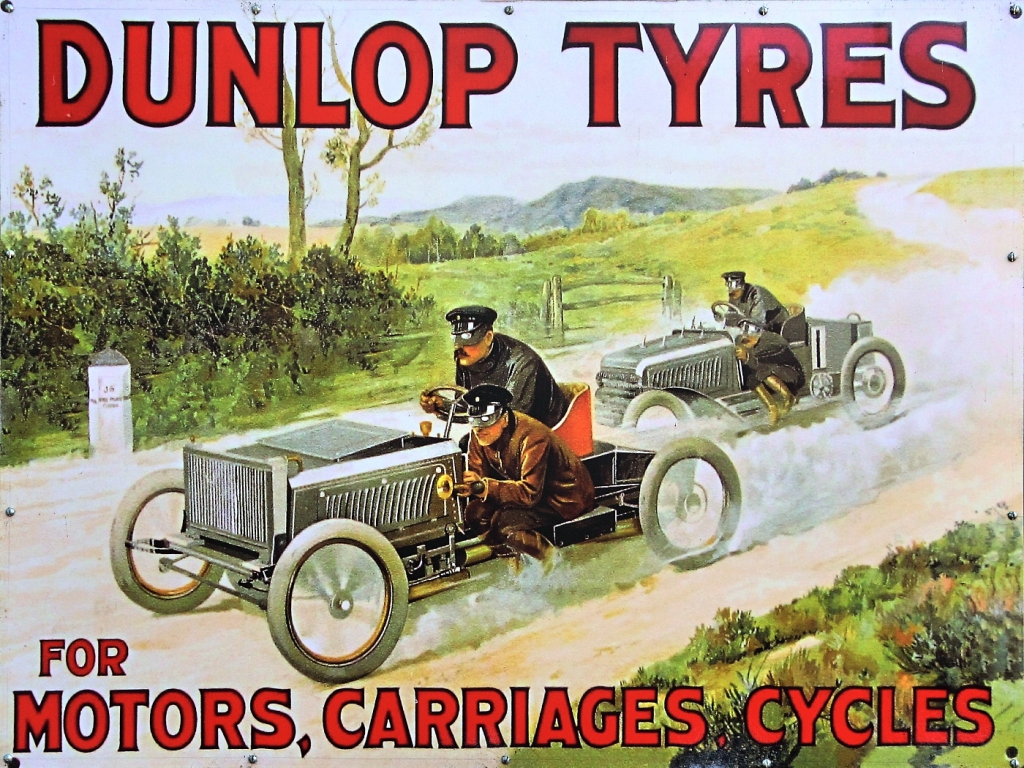
Motor vehicles and
garages
It is not known for sure who was the first to own a motor vehicle in Tring, but strong
contenders for the honour are Gilbert Grace, the ironmonger; Walter
Thomas, manager of Tring’s first power station in the old Silk Mill
premises; and, possibly, Lord (Nathaniel)
Rothschild.

Walter Thomas’s car parked outside the Silk
Mill
Several firms in the town applied to sell motor fuel, the first being in
1895 at Grace’s premises in the High Street, the local press reporting
that “plans have been passed
for Mr Gilbert Grace’s petroleum store as long as a ventilation shaft is
erected”. Gilbert’s love of motoring was passed down to
his son, Harold, who later became a successful racing driver
specialising in Riley cars. Before
long Wright & Wright and Gower’s Garage, both in Western Road, obtained
petrol licences, and they were followed by Roberts & Marriott [1] and
The Market Garage in Brook Street.
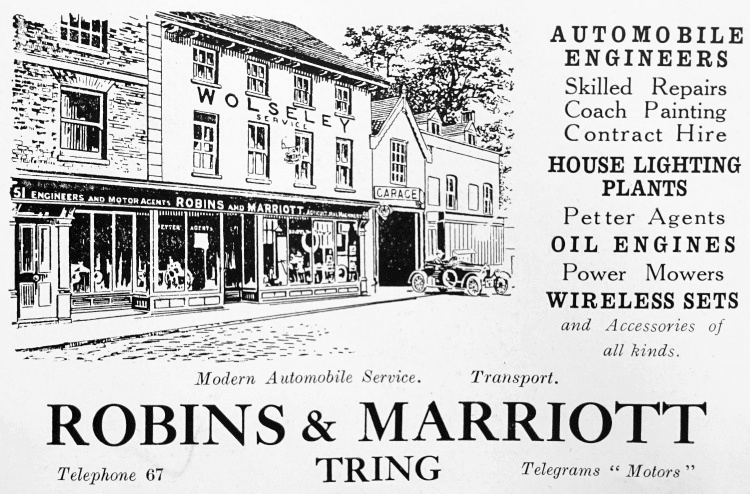
Advertisements for some of Tring’s former
garage companies.
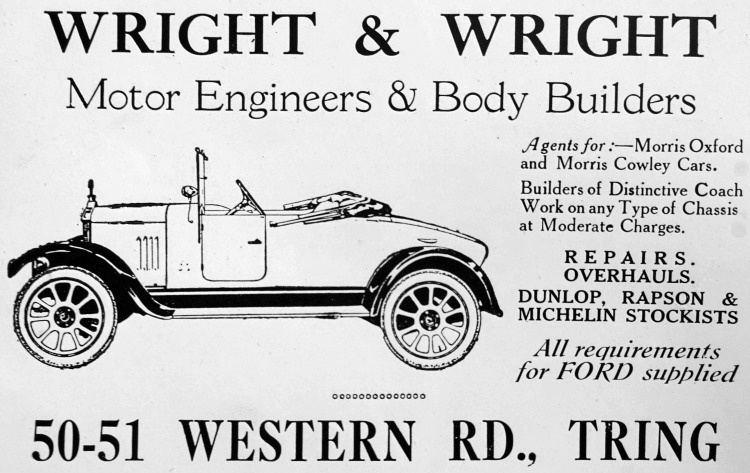
|
WRIGHT & WRIGHT, Coach and Motor
Body Builders and Garage Proprietors, Western Road, Tring —
Messrs. Wright & Wright’s
motor works, situated near the Britannia, were established here
in the year 1870 by Mr. George Parrott, who took Mr. A. S.
Wright into partnership in 1901. Mr. Wright, who is a
native of Tring, succeeded later to the business, and took into
partnership, in 1911, his cousin, Mr. R. G. Wright. The
premises have recently been enlarged, and are equipped with
plant for vulcanizing, mechanical repairs, etc. There is a
garage for about twenty cars. The firm are district agents
for the Mors, Ford, and the Maxwell cars. The chief work
of this firm in recent years has been body-building for motor
cars for pleasure or business. Tele. No. 12.
Advertisement, Pictorial Record,
1916 |

Wright & Wright expanded to become Tring’s largest motor business, and
by the start of World War I had obtained orders to construct small
trucks for the War Office. In 1919 an order was obtained to design and
produce the bodywork for a prototype of the prestigious Cubitt car,
manufactured in Aylesbury, [2] and the firm’s
coachbuilders subsequently built a number of bodies for both 2- and
4-seater models. In the photograph below, the firm proudly claims “vehicles
of every description built to order”!
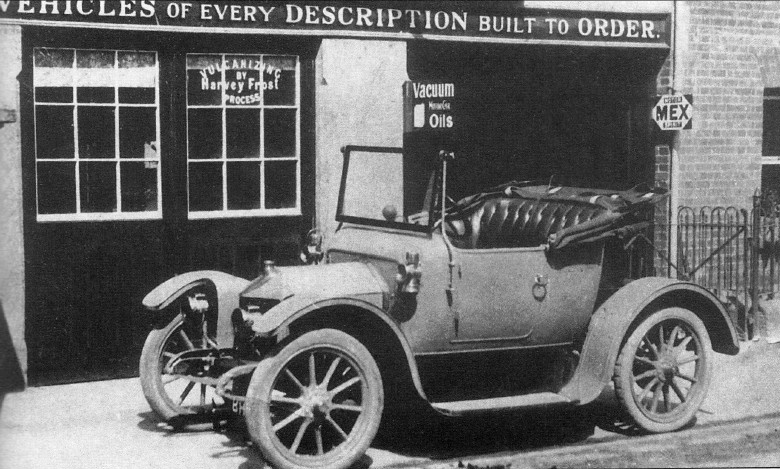
From an age when motor vehicles were built
in Tring.
A Wright & Wright-built
open-top car displayed outside their garage in Western Road.
At various times the business held dealerships for Ford, Austin, Rover,
Morris and Wolseley cars. Wright & Wright’s premises finally disappeared from the Tring scene in
1999, when the site was redeveloped for housing, but the Market Garage continues to serve motoring
needs.
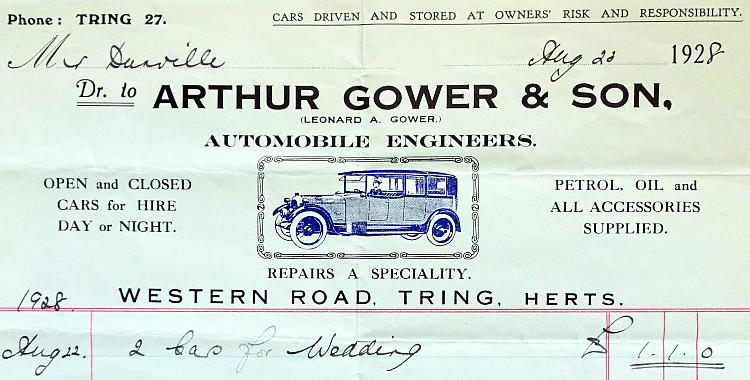
|
Above: Gower’s bill for providing “2
cars for wedding”, but from a later era than the Gower limousines pictured
below.

|
ARTHUR GOWER, Garage and Livery Stable
Proprietor, Tring Motor Garage, “Goldfield,” Western Road, Tring.
− Mr. Arthur Gower, a native of Tring, has carried on business at
his present address for the past quarter of a century − a length of
period which is sufficient indication that he is accustomed to
satisfy his patrons. To meet the needs of the new industry,
the motor car traffic, Mr. Gower has built additional premises and
garage. He has three cars for hire, cars of a superior type −
a Vauxhall holding six persons, and two Charron cars, also holding
six. Carriages for weddings and for funerals are available,
also, for supplying to the undertakers, a glass hearse. The
two brakes, each holding seventeen persons, are well known in Tring,
and always in demand at holiday times. Tele. No. 27.
Advertisement, Pictorial Record, 1916 |
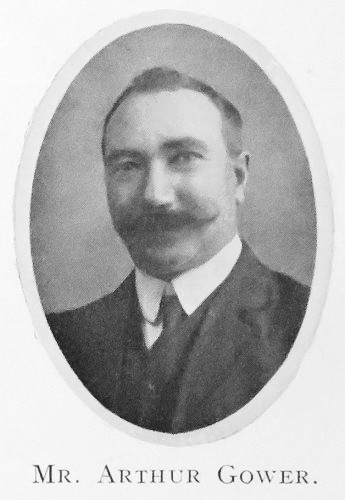 |
|
In addition to the existing taxi service available from Gower’s Garage,
by the 1920s several enterprising businessmen in the town were offering
char-a-bancs for private hire by clubs, church groups and others for
outings and ever-popular excursions to the seaside. The proprietors
included Ebenezer and Frederick Prentice, and Frederick Rolfe ― who exchanged the bodywork on the chasses of his winter-months’
coal delivery lorries for char-a-banc seating in the summer (see below). |
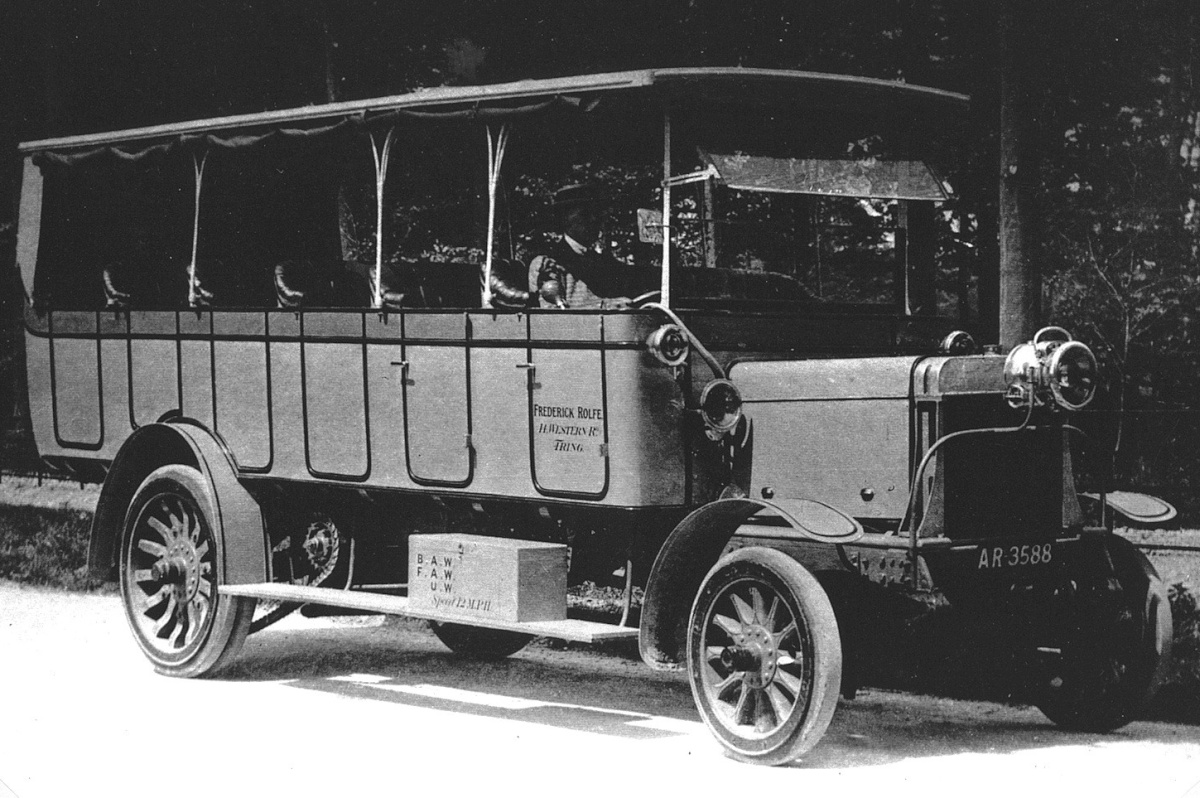

In 1913 ― some of the versatile Frederick Rolfe’s summer
(above) and winter (below) businesses activities.
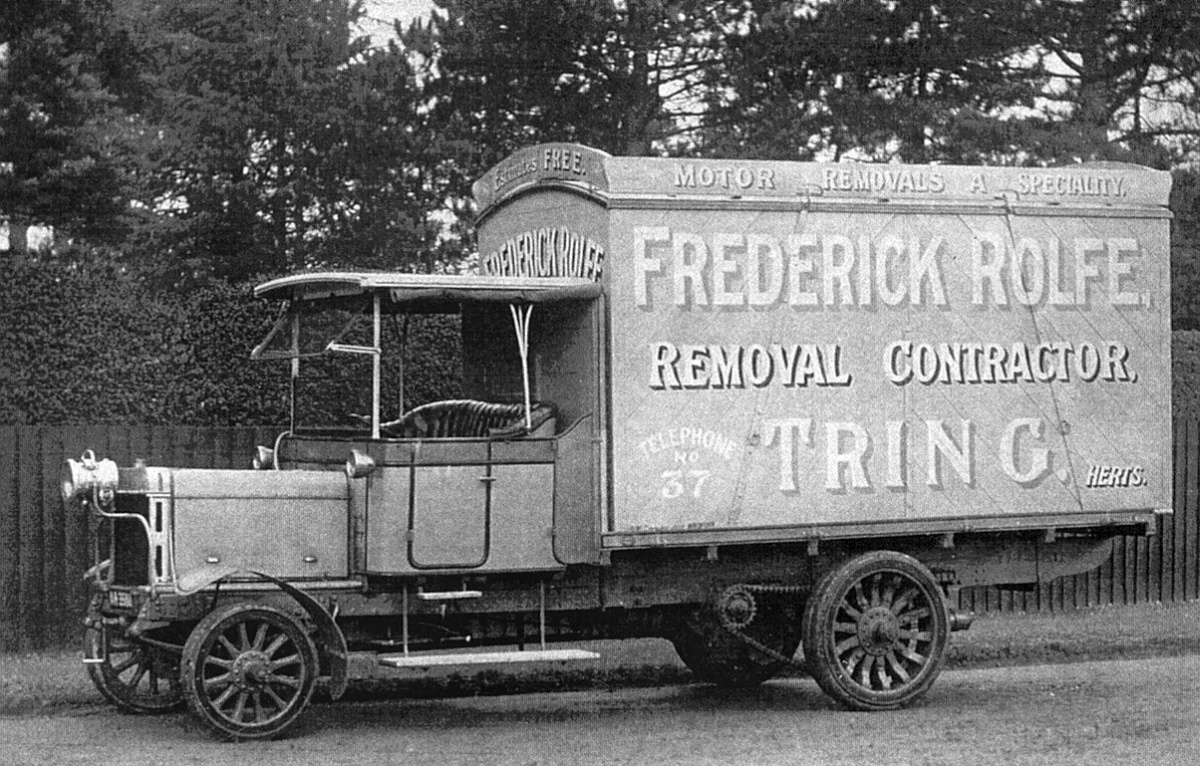
|
Road construction
Tring Urban District Council (UDC) was formed under the Local
Government Act 1894 as the successor to Tring Local Board of Health.
It held its first meeting on 3rd January 1895 and until April 1974, when
the Urban District was absorbed into the Borough of Dacorum, the UDC
governed Tring. Looking back, the scope of the UDC’s
responsibilities now appear surprising (if at times somewhat amusing) ―
for instance, the following are some of the subjects discussed at a UDC
meeting held in June 1896:
“The Surveyor was instructed to warn butchers not
to hang meat over the footpaths. ― The Council decided to enforce
regulations that no part of a shop blind should be less than 6ft 6 in.
from the pavement. ― Mr. Joseph Clarke’s application to be registered as
a cow-keeper was granted. ― Mr. Jeffery Stratford’s petroleum licence
was renewed for one year. ― A sample of water from Tabernacle Yard was
ordered to be sent for analysis to the Medical Officer for Health. ― The
Surveyor and the Highways Committee were instructed to ascertain the
cost of granite for the Station-road. ― Councillor Grange called
attention to the dangerous turning into Cow Lane from the London Road,
and the Surveyor was instructed to arrange with the Surveyor for the
County Council for improving the same. ― Attention was called to the
delay in obtaining horses for the conveyance of the Fire Brigade when
summoned to fires. The Surveyor was requested to confer with the Captain
of the Brigade, to see if some better arrangement could be made.”
Highways were part of the new Council’s
responsibilities, and a Highways Committee was formed to oversee and
manage their condition.
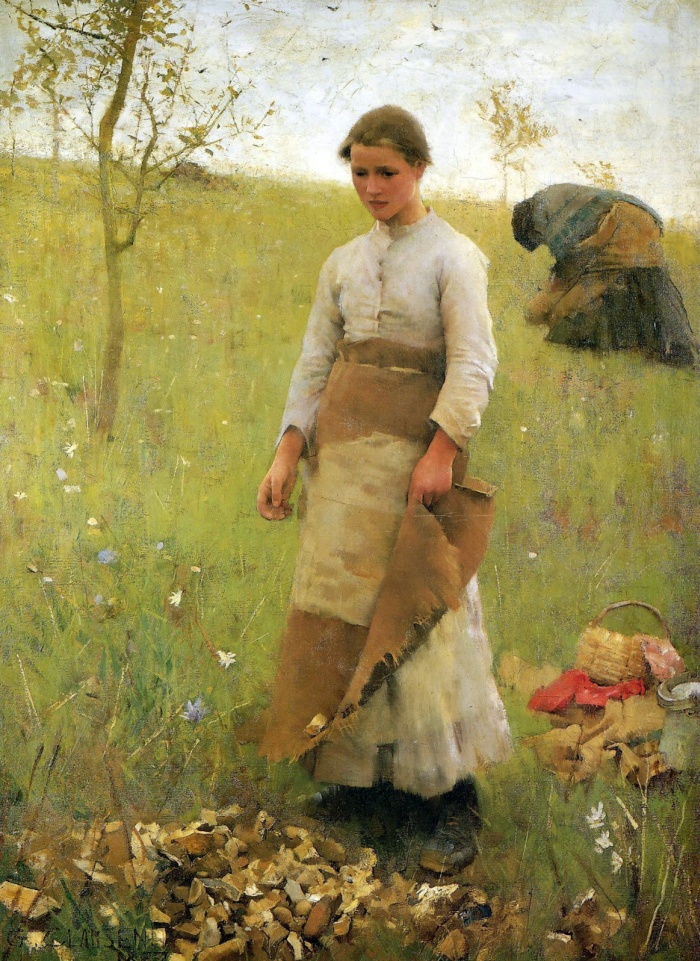
The Stone Pickers, by George Clausen (1887).
|
BREAKING ROAD STONE.
TRING URBAN DISTRICT
COUNCIL: “THE
WAGES OF THE ROADMEN
. . . . a man ought to be able to earn 3d an hour at
breaking stones, and the Surveyor ought to know whether it
was worth 9d. or 10d. to break a load of stone. There
was no doubt a great difference in the quality of the
stones, but if the pay was an unfair price, then it ought to
be increased. ― The Chairman said if the Surveyor thought
more should be paid he could pay it. ― Mr Bishop said in the
summer months there was no stone-breaking done, and that if
the men went to Cholesbury it was worth more to break
stones, and then they had all weathers. ― Mr Baines and Mr
Bishop did not seem to understand that they had only two men
who broke stones by the piece. They had two very old
men who worked by the day. He had one young man who
broke eighteen loads one week and twenty-two the next,
earning 13s. 6d. [67.5p]
and 16s. 6d [82.5p].
The two old men, Wilkins and John Adams, earned about 8s.
[40p] or 9s.
[45p] a week.”
Bucks Herald, 6th July
1895 |
At the time when Tring UDC was formed, that part of the
Sparrows Herne Turnpike Road
passing through the Town had been returned to Council care (1st
November 1873), added to which were all the Town’s other roads, lanes
and public footpaths. Apart from the occasional steam road
locomotive,
most traffic went on foot or by hoof, for which the roads of the time were adequate. The more important roads were ‘metalled’,
which meant that they were
built on a sub-layer of broken flint or ironstone slag over which was
laid a surface of compacted gravel.
Flint, which is plentiful in this area, was a nuisance to farmers, so
those receiving parish relief ― often women and children ― were employed
to pick it off ploughed fields to be used for road maintenance; for this
they were paid between 8d and 1s. per cubic yard. Flints were also
quarried from the naturally occurring pockets found in the
Cholesbury/Hawridge area. Men were then employed to
break the flints so collected into a suitable size for road use.
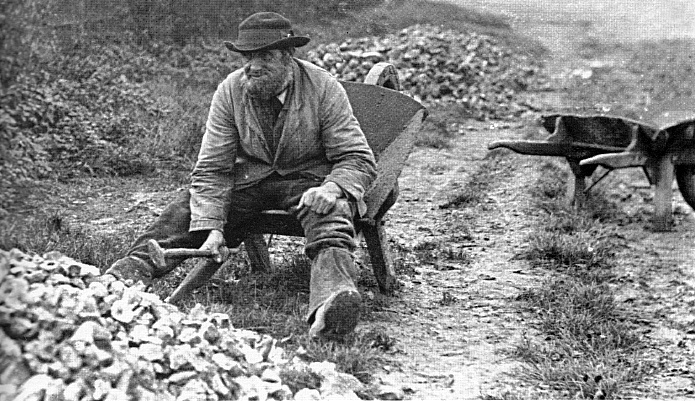
Charles Delderfield of Aldbury breaking
roadstone.
Born in 1843, Charles was blinded in one eye by a flying
stone splinter. He lived into his 90s
Slag ― a solid waste by-product produced in the manufacture of of iron
and steel (and used by the Romans in road building) ― was sometimes used
as an alternative to flint, such as its application to Station Road in
1896:
“Several Councillors referred to the very
unsatisfactory character of most of the flints supplied recently, and
the Surveyor said there was very great difficulty in obtaining clean
picked flints. The general opinion being that the cost of granite
was too high, Councillor Stevens suggested ironstone slag, which he had
seen used with much success. In the discussion which ensued, it
transpired that the principal objection to the use of slag is that in
damp weather it emits a rather strong, but not unhealthy smell.
Ultimately, Councillor Stevens proposed, and Councillor Crouch seconded,
‘That we use slag on Station Road from the boundary of Aldbury parish to
Cow Lane.’ Four voted for the motion and three against, so that it
was carried.”
Bucks Herald,
5th September 1896
The annual reports of the Surveyor to the UDC give an interesting
insight into the extent that (when the Town was self-governing) the UDC
managed our roads, a different situation to that which prevails today.
Perhaps 1911-12 was a particularly busy year, for a great deal of road
work seems to have been done:
“. . . . The highways that have been metalled
include parts of Hastoe Lane, Gladmore Lane, Cow Lane, Station Road,
Bulbourne Road, Wingrave Road, Grove Road, Marshcroft Lane, Brook
Street, Icknield Way, Frogmore Street, King Street, and Henry Street.
The materials used on the above work include 362 tons of granite, 46
tons of chippings, 417 tons of gravel, 1,972 [cubic]
yards of flints, and 248 loads of brick rubble. The steam roller
has been employed for 94 working days. The nett cost of the work
on the highways was £1,750 4s. 1½d.”
Tring UDC Surveyor’s report on the
highways, April 1912
Laying the dust
Tarring.
In the years leading up to World War I., the townsfolk of Tring began to
witness a move away from the McAdam
type road surfaces described above,
to the sealed road surfaces we
have today.
No doubt our forebears were as familiar with potholes as we are,
but they also had to contend with road dust. One problem (there
were others) that the new motor vehicle brought with it was the clouds
of dust it raised in dry weather from the unsealed road surfaces of the
time. Tring’s shopkeepers complained that their wares ― which at
that time they often displayed in front of their premises ― were
becoming coated with road dust during dry weather while being immersed
in a dust cloud was an unpleasant experience for pedestrians and other
road users. |

The progress of the early motorist along the unsealed
road surfaces of that era
was marked by a trailing screen of dust
|
Other problems presented by unsealed roads ― particularly those where
flint in the sub-layer became exposed ― was that of the sharper and
larger stones cutting and puncturing the new pneumatic tyres, or being
thrown up by the vehicle wheels and damaging the underside, especially
puncturing vehicle fuel tanks. Loose gravel also skipped up
hitting the car body, lights or windshields when vehicles passed at
speed. And so the battle against road dust and loose chippings
commenced. In an attempt to combat the problem, the Council decided to
employ tar as a sealant, and they
selected Station Road for the trial:
“Mr Asquith suggested that tar should be tried with granite
[chippings] on a length of the main road.
This would produce a better road, its life would be increased, and it
would be practically dustless. He (Mr Asquith) also thought the
granite used on the roads was too small, and not of quite the right
character. A less brittle granite of not less than two-inch gauge,
laid on a bed of asphalt and steam-rolled, would give a road which would
yield the minimum dust in dry weather, and the minimum of mud in wet.
This would not materially increase the estimate, and any additional
first cost would be more than saved in the increased durability of the
road. Anything, too, which would reduce the dust nuisance was
very desirable in these days of mechanical traction . . . . it was
resolved that the report of the Highways Committee be adopted, and that
the Committee be empowered to spend £25 in treating a length of Station
Road as suggested.”
Bucks Herald, 8th June 1907
Amazing what you could then get for £25!
The Station Road trial was
successful, for in November 1912 the Town Council decided to tar-spray
the whole of the road together with London Road, the High Street,
Western Road and Aylesbury Road, all at a cost of £270; it was hoped
the Road Board would
contribute towards the cost, but
for some unknown reason they declined. Nevertheless, the
project went ahead and in June of the
following year the Bucks Herald was
able to report that:
“. . . . the work of tar-spraying provided for
in the estimate had been completed, and that he [the
Surveyor] had got out the cost, from which it
appeared that a net saving of about £44 had been effected. He also
stated that he thought that if the area previously watered was not
extended, a saving of about £40 could be made on that item; and he asked
for instructions as to whether it was desired to carry out any further
tar-spraying . . . . It was decided to recommend that Akeman Street,
Frogmore Street, Langdon Street and Lower Albert Street be tar-sprayed
at an estimated cost of £44 . . . .
The Rev. Charles Pearce referred to the excellent way the tar-spraying
had been done. ―
Mr Batchelor endorsed this, and said that several anti-tar people had
been quite converted.”
Bucks Herald,
14th June 1913

|
Mending the road ― stones without tarring ― between Long Marston
and Dixon’s Gap c. 1933. The caption on the photo states that
the stones were delivered to Marston Gate
Railway Station and Mr Cartwright fetched them with his horse and
cart. |
By February 1914, the Town Council’s road improvement plans had
been extended to include tar-spraying Parsonage Place, King
Street, Charles Street and Park Road, for which purpose a
contract had been placed for the supply of 12,500 gallons of tar
at 4½d a gallon. By June of the following year the work
had been completed; the 20 barrels of tar remaining were
used to treat Longfield Road, left out of the original plan to keep
the overall cost
within estimate.
In receiving a tar-and-chippings surface, Miswell Lane appears
to have been the Cinderella of the Town’s old roads. At a
Highways Committee meeting held in July 1919, the road was
reported to be in
“a bad state, the surface being very rough and
dangerous in places”. However, the Surveyor
reported that there was no money in the budget to deal with the
problem; at their next meeting, the Committee decided to defer
consideration of tarring until the following year’s work was
planned. Nothing further is then heard of the problem, so
it must be assumed that Miswell lane was tar-surfaced during the
1920s.
And so ― even if they do come in for much criticism in the
present age ― Tring’s roads gradually acquired modern
sealed surfaces.
Street watering.
Street watering was another technique used to combat road dust, and for
other purposes that no longer apply.
Here, the Town Council commissioned Gilbert Grace, a local ironmonger,
to fashion a water-sprayer for attachment to one of their carts:
“With regard to street watering it was decided that no additional
watering should be undertaken, and that High Street should be watered
once a day, but that the other tar-sprayed roads should not be watered.
― Mr
Asquith pointed out that if any extension of watering was possible, New
Mill was entitled to a little attention.
― Mr Batchelor
replied that the question was before the Highways Committee the previous
evening, but they decided they could not see their way to find the
money.”
Bucks Herald,
14th June 1913
Tar also has a propensity to melt, so until it was replaced
by bitumen, which is less
temperature sensitive, the water wagon was also used to cool road
surfaces in hot weather. In his rhyme below (‘The Water Cart’), Ron
Kitchener refers to a further use for the water wagon, that of disinfecting
the road in an age when there still much hoofed traffic about, which,
inevitably, left its calling card. The photograph below show
Tring’s water wagon at work in the High Street, probably during the 1930s.
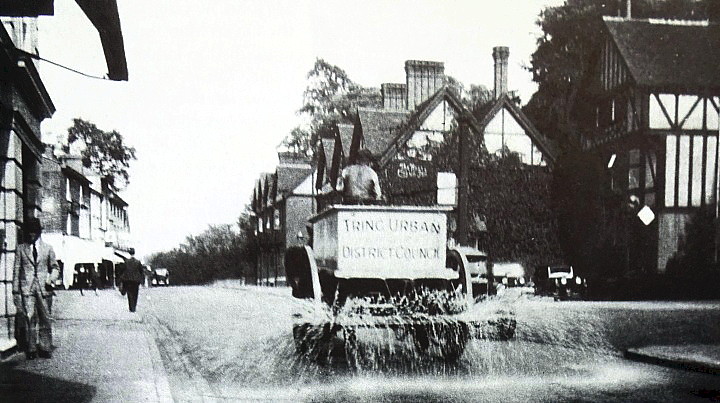
The Tring Urban District Council water cart
at work outside the Rose & Crown.
|
The Water Cart |
|
You’ll remember the “Tarring”
Which was really well done,
Well! Along came a Water Cart
To cool tar from Sun.
A loose drawing Cart,
Shaped like a Drum
With pipe like a watering can,
To cause so much fun.
For the long scorching Summer,
It would water the ways,
And lay all the dust
From the hot sunny days.
If that wasn’t the purpose
Then maybe much more,
To spread disinfectant
To sweeten the floor! |
Perhaps a tradition
or a product of time,
When livestock paraded
To leave much behind.
Or maybe amusement,
As watering came,
For children did love it
And thought it a game.
A kind of free shower
To give feet a bath,
Whatever the reason
It made many laugh.
Ah! Now for the progress,
They don’t do the same,
that’s all a redundant,
To wait for the rain. |
|
Ron
Kitchener,
from JUST “RAMBLING”
ON WITH
ME. |
Tring’s early bus
services
On 20th July 1837, the London & Birmingham Railway Company commenced
operating a train service on the newly-completed section of line between
Euston and Boxmoor. The new railway had an immediate impact on the local stagecoach
business, although their proprietors cannot be criticised
for lacking adaptability. These notices from the Bucks Herald for
August, 1837:
|
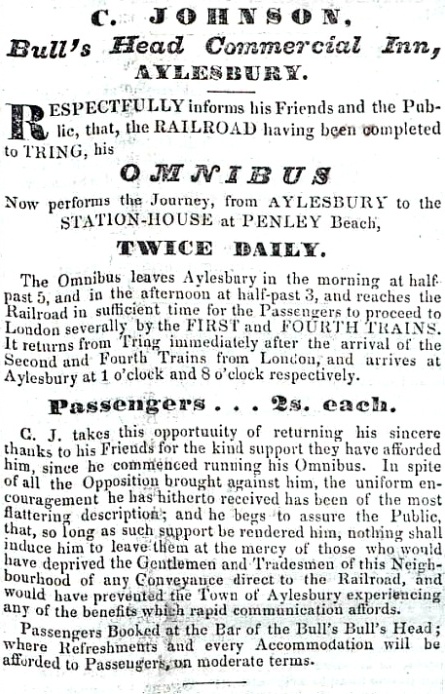 |
|
Station omnibus service,
Bucks Herald 21st October 1837.
‘The
Station-House at Pendley Beach’ refers to Tring Station. |
“Jospeh Hearns begs also to announce that his coaches from Tring to
London and from Hemel Hempstead to London are discontinued, and which,
in future will meet the respective trains from Tring at Box Moor and
also from Gaddesden, Ashridge and Hemel Hempstead at Boxmoor.”
“John Elliot, Carrier of Aylesbury: Respectfully informs his Friends and
the Public that he intends conveying Passengers and Luggage every
Monday, Wednesday, and Friday mornings from the Angel Inn, Aylesbury
(where Passengers may secure places) to the Station House at Box Moor,
and that he will start from Aylesbury at six o’clock each morning, and
leave Box Moor at six o’clock the same evening. Passengers 2s. each
extra luggage to be paid for.”
“Chas. Johnson, Bull’s Head Inn, Aylesbury respectfully informs his
friends and the public that he has commenced running an Omnibus from
Aylesbury to Box Moor, and back, daily.”
And as the line extended northwards ― Tring being reached on the 16th
October ― the local coach operators adapted to the changing situation:
“The Tring Station on the Birmingham railway is two and a-quarter-miles
from the town, and thirty-one and three-quarters from Euston Square.
Conveyances attend at this Station on the arrival of several trains, to
carry passengers to Tring, Aylesbury, Oxford etc. Passengers intending
to join the trains are desired to be in good time, as the train leaves
each place as soon as expeditiously as possible. No persons are booked
on the railway after the arrival of the train in the Station.”
Pigot’s Trade Directory 1838 – entry for Tring
“A Coach from the Plough Inn, Tring, to meet all the trains, and an
Omnibus from the Rose & Crown, Market Street, Tring: Elizabeth Montague,
Post Mistress – Letters from London arrive (by railway) every afternoon
at one and night at eleven, and are despatched every morning at four and
forenoon at half-past eleven. Letters from the North (by railway) every
morning at half-past five, and at twelve, and are despatched every
morning at three.”
Pigot’s Trade Directory 1839 – entry for Tring
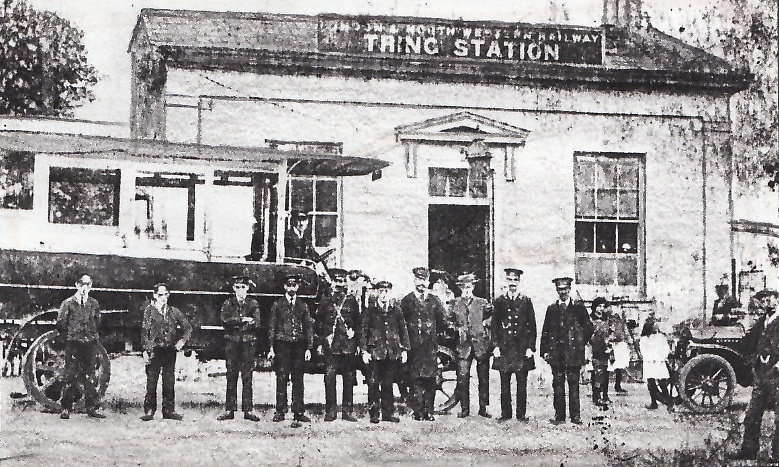
Tring’s first petrol-driven
bus (1914)
Thus, Tring’s earliest bus service can be said to have commenced on the
opening of the town’s railway station in October 1837. Bus services to the station continued to operate under various
ownerships. In 1846, the London & Birmingham Railway became a
constituent of the London & North-Western Railway Company, which
operated a horse omnibus (Chapter 6)
between the town (The Rose & Crown Hotel) and its station until February
1914, when the petrol engine replaced horse traction:
“The horse ’buses ran by the
Tring Omnibus Company have been replaced by motor ’buses
belonging to the Railway Company, which have provided more rapid, if not
more reliable, communication between the station and the town.”
Bucks Herald, 2nd January, 1915

Towards the end of WWI, a service was provided for the transport of
passengers and general deliveries, calling at Bulbourne, Pitstone and
Ivinghoe.
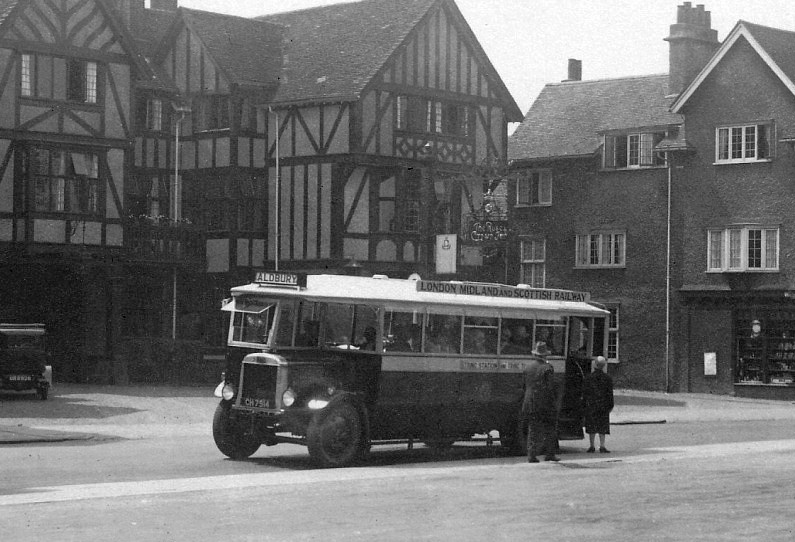
A Leyland Lion with LMS bodywork about to
depart from the Rose & Crown for Aldbury
Following WWI and the railway Grouping, [3]
the London Midland & Scottish Railway Company operated a fleet of buses
in the Tring and Hemel Hempstead areas, most being Leyland Lions fitted
with bodywork built in the Company’s Derby workshops.
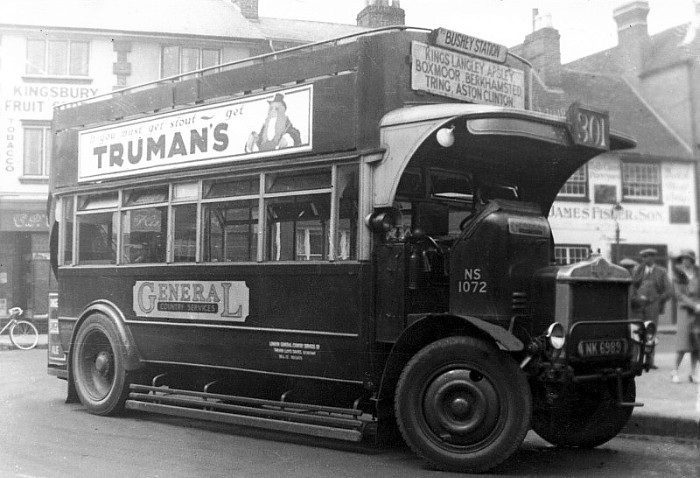
A London General AEC NS-type bus on route
301 (Aylesbury ― Bushey) at Aylesbury c.1932.
This open-top vehicle (top speed 20
mph!) entered service in 1924 and was withdrawn ten years later
This fleet was taken over in 1932 by London General Country Services
and, in the following year, by the newly formed London Passenger
Transport Board, [4] Tring being just within the
North-Western boundary of the Board’s operations.
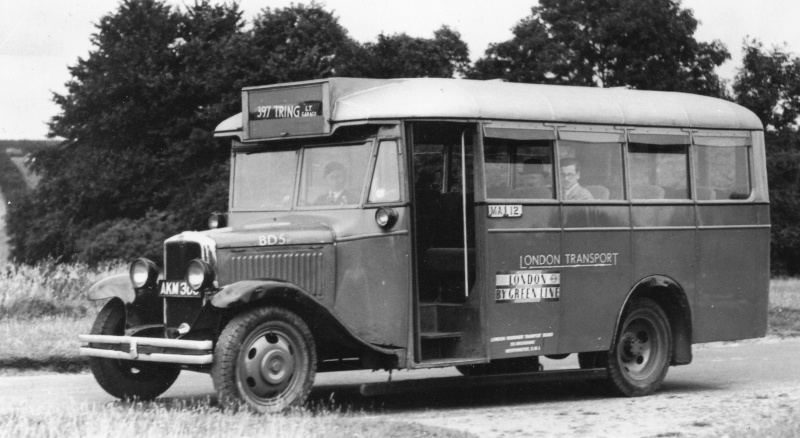
A Leyland Cub on the 397 service (Tring ― Chesham) heading
for the ‘LT Garage’ at Tring
The Tring Bus Garage,
Western Road
At this point it is appropriate to mention a long-departed local
landmark, the Tring Bus Garage. Built in the London Transport style, it
stood in Western Road on the site now occupied by the Royal Mail sorting
office.
The garage’s history began in 1925 when E. Prentice & Son set up the
Chiltern Garage, on the site of the former Gem Cinema, advertising
themselves as motor engineers and char-a-banc proprietors. The
firm also had an interest in local bus services. Prentice & Son was acquired
in 1932 by London General Country
Services, which in the following year was absorbed by the London
Passenger Transport Board, the logo ‘London Transport’ then adorning
their buses (see above, although this bus is being operated by London
Transport’s Greenline subsidiary). |
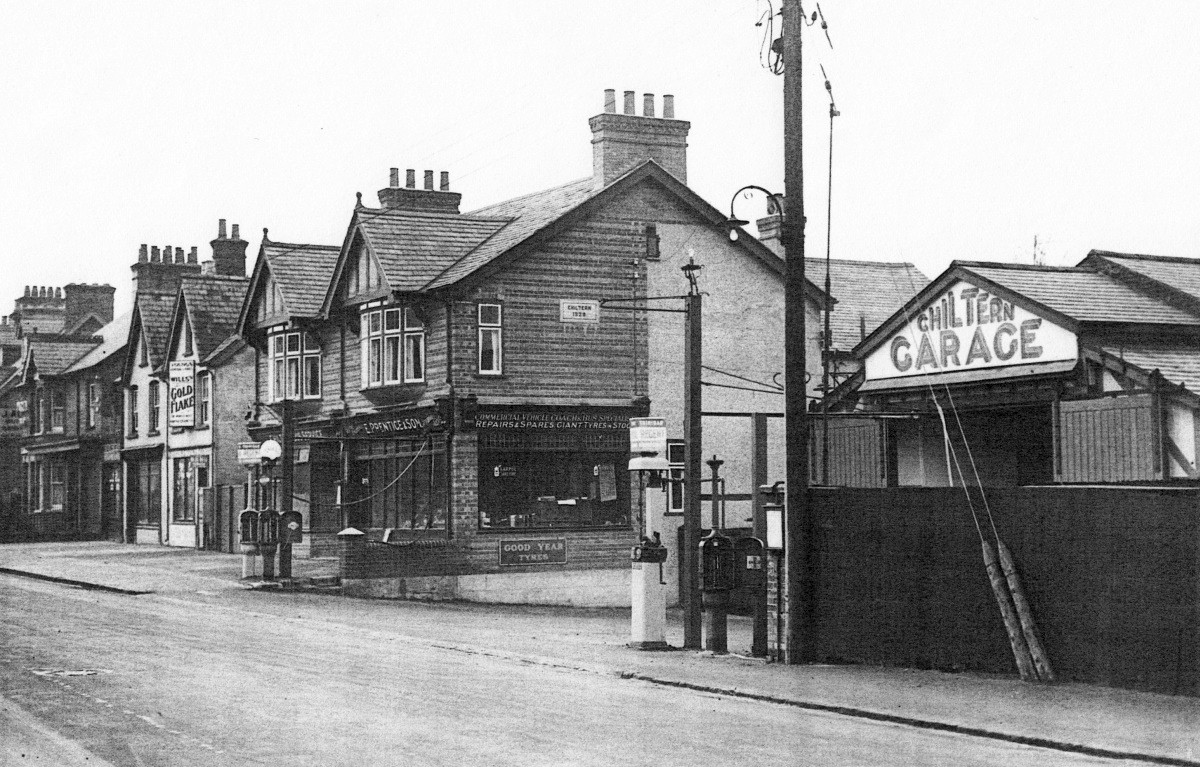
Above, the Chiltern garage, Western Road, in
1931. Below, some of the company’s bus fleet
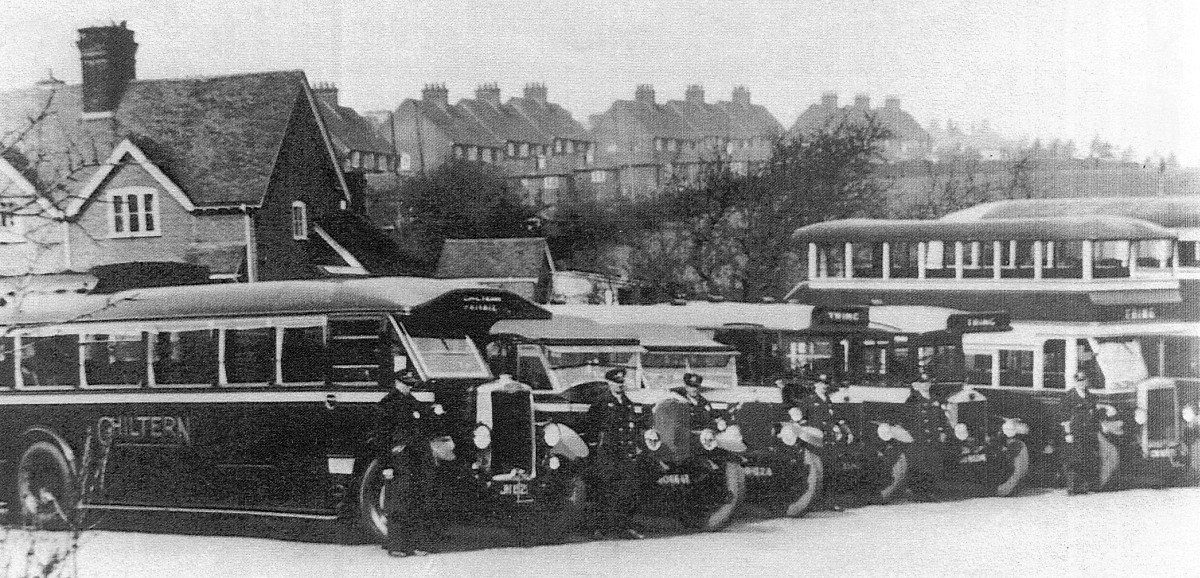
|
In 1935, London Transport opened a large Art Déco-style bus
garage and
office in Western Road on the site of the former Chiltern Garage to
serve the needs of the Aylesbury to Watford service and other local
routes. The Board also began to advertise a bus service passing through
Tring, London and into Kent operated by their Green Line Coaches
subsidiary.
Tring was one of London Transport’s smaller garages, with less than 20
buses and coaches stationed there. Probably for this reason it was
closed in 1977, the site then becoming a depot for Unigate Dairy before
assuming its present role as a Royal Mail sorting office. [5] |
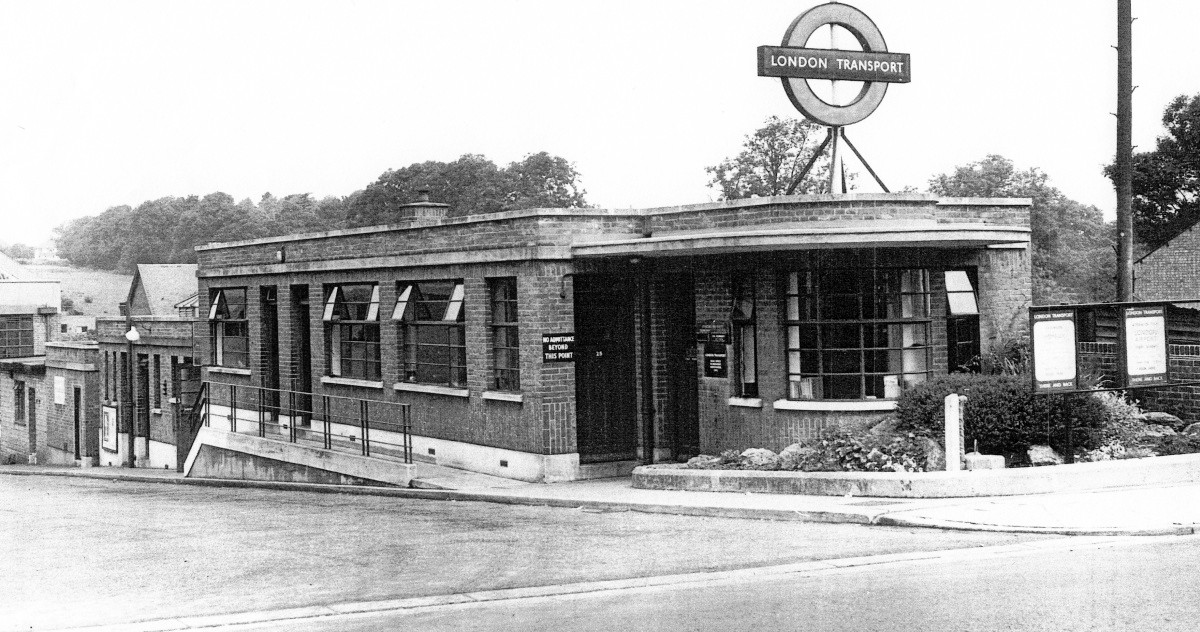
The London Transport bus garage, Western Road, Tring.

‘Our
Local Bus.’
|
You could tell the time for sure,
As Bus switched on the power,
Twenty past and twenty to
And then upon the hour.
You could choose to go up top,
With slatted sides so plain,
Tarpaulin sheets to cover up,
In case it turned to rain.
A staircase open and outside,
And up that you could pop,
One curved brass rail a winding,
To help you to the top.
Two rings would start Bus on it’s way,
One ring would make it stop,
One long cord from front to back,
Conductor did the lot.
That was many years ago,
Now progress has been made,
Diesel powered and modernised,
With so much to be paid! |
The Driver is a one-man crew,
You pay as you go in,
No longer any open top,
You all can sit within.
No “Ding Ding” or even “Dong”
If Bus has come your way,
So lucky if it comes on time,
You could wait there all day!
The Driver and Conductor,
Were friends of yesteryear,
They greeted you so cordially,
And fares were far from dear.
Now we get from here to there,
Who could say more than that,
It’s more like sitting in a Hearse,
There is no friendly chat.
There seems no pride or courtesy,
No one to really care,
Something we left so far behind,
The modern way to share. |
The Bus no longer
gleaming bright
To give a friendly pat,
It’s just the local transport,
I’ll say no more than that! |
|
|
Ron
Kitchener,
from JUST “RAMBLING”
ON WITH
ME. |
――――♦――――
The post-war era
After WWII as modern communications improved and the original pipe work
laid by utility companies under Tring’s main road started to wear out
and drastic digging was often required. The best efforts of the Civic
Authorities were not always appreciated, and exasperation probably led
Reverend Hearn of Tring’s United Free Church to pen this verse on 12th
May 1950 (as might be expected from a clergyman, this poem about Tring
High Street ends with a telling analogy):
|
‘THE BROKEN ROAD.’
They laid it down with utmost care,
Expense they did not seem to care
To make it good they worked so hard
The camber right, the surface tarred
The central line done in white
With ‘cats eyes’ shining in the light
A roadway worthy of the best
If only they would let it rest
But no, their work was all in vain
They had to dig it up again
For whilst the traffic safe did go
They had not put some pipes below
They marred what seemed a perfect strand
And all because they had not planned.
So life may be a broken road
Because we reap what we have sowed. |
In the 1990s, similar complaints could be heard the cost of the road
improvement scheme through the town centre, which caused considerable
noise and chaos while the work was in progress. The Highway Authority
had taken up with seeming enthusiasm the fashion of laying fancy
block-paving instead of the more mundane tarmac. Although the outcome
looked attractive, it proved an unsuitable road surface for a busy town
centre high street. The constant transit of buses and other heavy
vehicles quickly exposed its weak points, especially around drain
covers, and it was not long before sections of the surface had to be
re-laid.
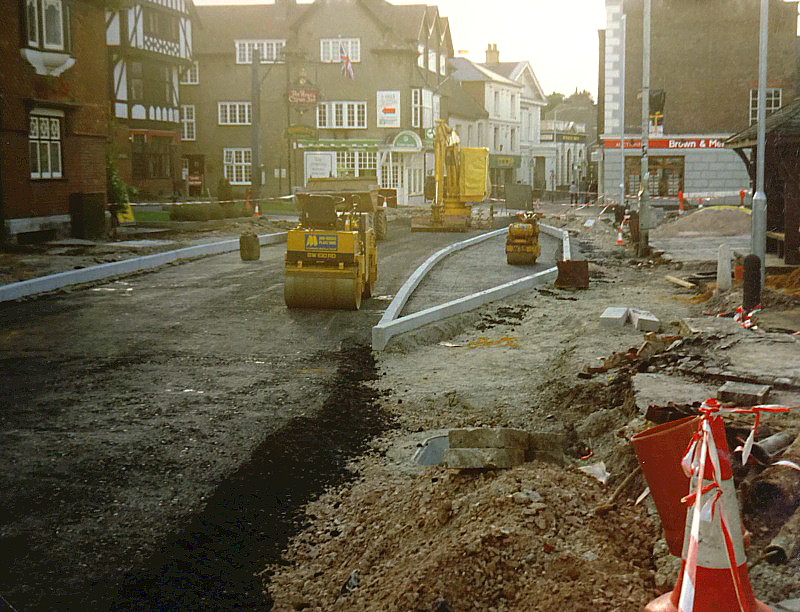
The High Street paving project, 1992.
The A41(M) Watford-Tring
Motorway
For many years residents of the towns along the A41 from Hunton Bridge
to Aston Clinton had to put up with the noise and congestion caused by
heavy traffic. This problem had first come to the attention of the road
planners in the 1920s, when consideration was given to by-passing
this section of road. Proposals were made in 1927 and 1928, in 1944 and
in 1951, but no steps were taken. Eventually in May 1971, the Department
of the Environment published proposals for what was named the A41(M),
which was to run for 15 miles from Watford to Aston Clinton, a mile or
two short of Aylesbury. Due to the inevitable objections, the Secretary
of State decided that a public inquiry should be held. Having considered
individuals’ objections and representations, together with the report of
the independent inspector who held the public inquiry, it was decided
that the majority of the route should be confirmed, but with some
modifications.
Plans were then developed to the stage at which the line of the motorway
was even marked on Ordnance Survey maps. The 2-mile Tring Bypass was
built as the first section of the proposed Watford-Tring Motorway, but
on its completion work stopped and what had become the Watford-Tring
Motorway project was quietly laid to rest.
The Tring Bypass, opened in 1973, was built to motorway standards,
although when it appeared that the rest of the motorway would not be
built, the Bypass was downgraded. In the meantime traffic on the A41
continued to increase until the need for a higher capacity road could no
longer be avoided. Thus, in the 1990s, a fast dual carriageway on the
same alignment as the A41(M) was built, but not to motorway standards;
it has no hard shoulders (although there are lay-bys) and the junction
designs are substandard, some might even argue ‘dangerous’. The new road
was completed from Junction 20 on the M25 to Tring in 1993. But what
about Aston Clinton, which was part of the original bypass scheme?
|
“In a few hours’ time my constituents in the village of Aston Clinton
will wake up to the rumble of lorries and the roar of cars passing
through their small village. I am grateful for the opportunity to bring
to the attention of the House the long wait that those villagers have
had for a road improvement first promised them in 1937, and to press on
my hon. Friend the Minister for Railways and Roads the case for the
Aston Clinton bypass to be given the highest possible priority, within
what my constituents and I accept is inevitably a finite road budget in
any one year.”
Hansard ―
David Livingstone M.P, House of Commons debate, 02 April 1996 |
In 2003, the dual carriageway was finally extended north of Tring to its
original destination with the addition of the 4-mile Aston Clinton
Bypass.
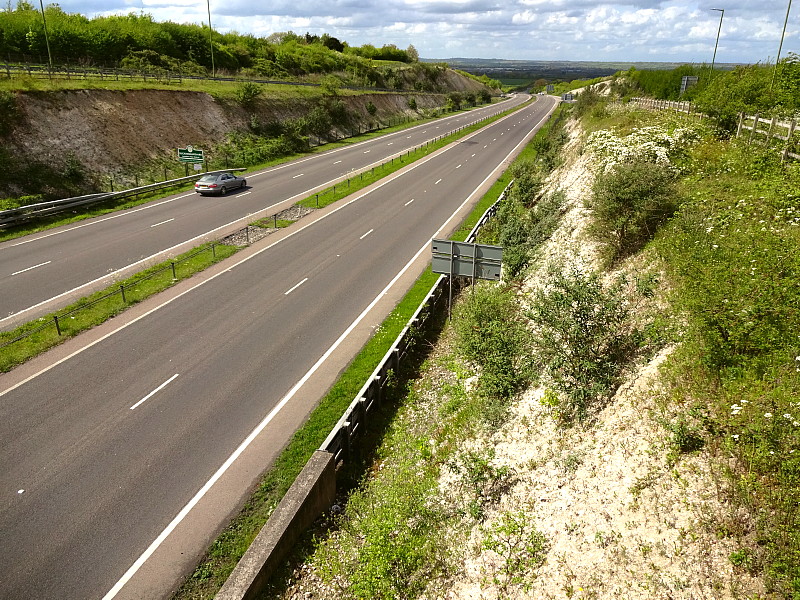
The Aston Clinton Bypass, looking north
from the Icknield Way Bridge
In 2003, the Highways Agency handed over control of this section of the
A41 to Buckinghamshire and Hertfordshire County Councils, at which date
it ceased to be a trunk road. This decision reflects the road’s regional
and local importance and the fact that, as a through route, it stops
short of Aylesbury. But at least it was built -- eventually.
The Tring By-pass
The 1970s was to see the biggest change to Tring’s main highway since
1711. For many years it was apparent that the town could no longer cope
with the volume of traffic, especially as the size of heavy goods
lorries increased. The need for a by-pass and the routes it might take
were discussed at length, and not without the usual vehement protests
that accompany such undertakings. None of the prospective routes was
ideal, for lines both north and south of the town would entail the
destruction of attractive countryside held so dear to the town’s
residents. The major concerns were that the northern route would dissect
land on the Pendley Estate, while the southern route would slice through
Tring Park; it was the southern route that was chosen.
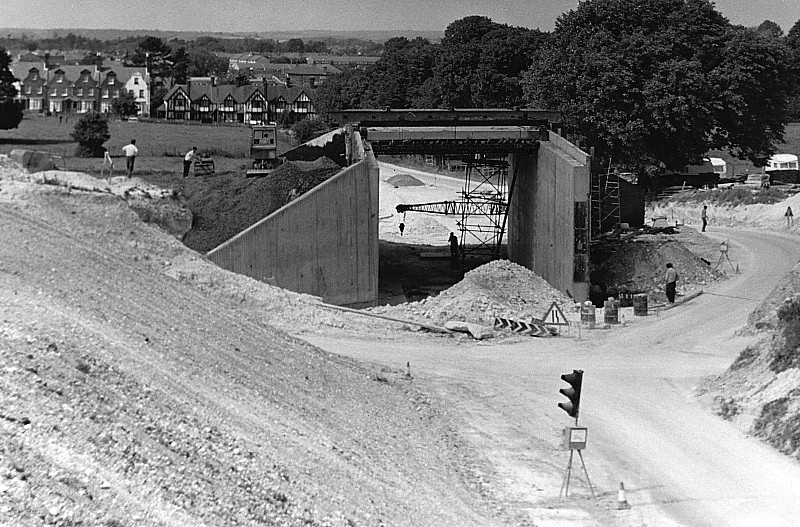
Above: the Hastoe lane
flyover under construction, July 1974.
Below: the
Tring Park footbridge under construction, September 1974.
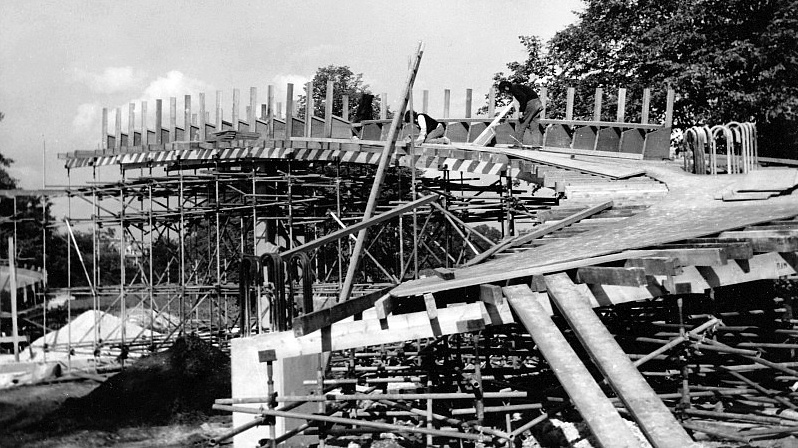
Despite Tring Park being sliced in two, the town welcomed the respite
from heavy traffic while the attractive footbridges over the Bypass
ensured that Tring Park remained easily accessible. Indeed, the bridge
over the Bypass’s eastern end (shown below) has become something of an emblem, being
known locally as ‘The Gateway
to Tring’ . . . .
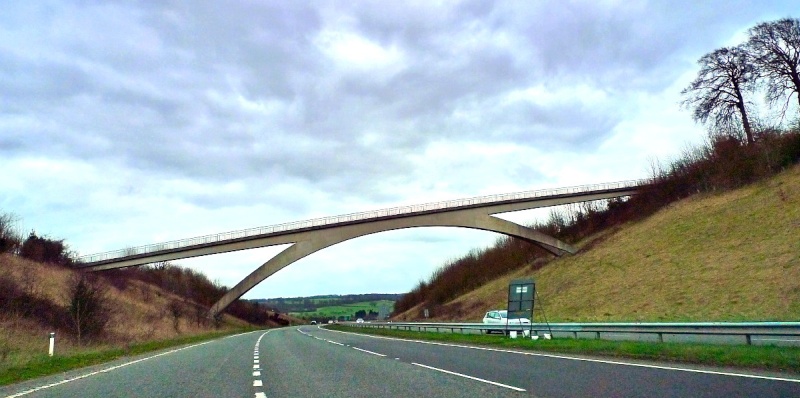
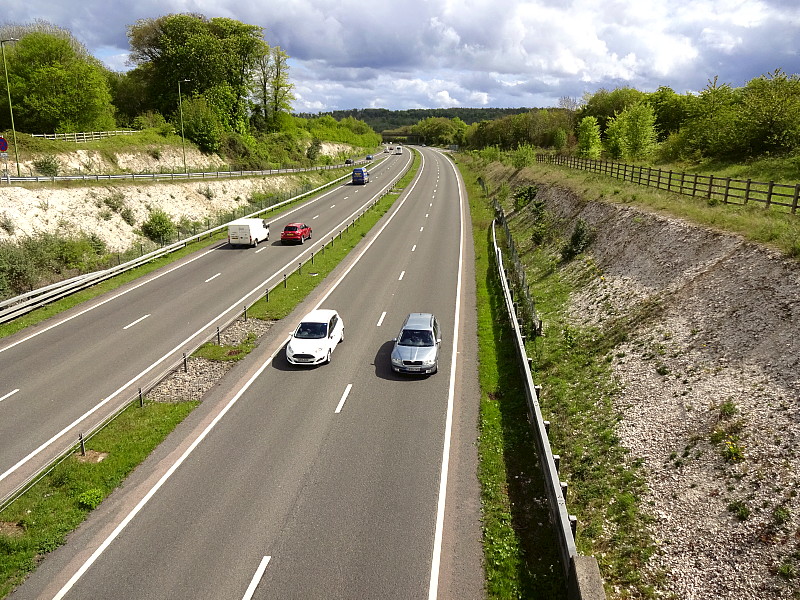
The Tring Bypass (A41), looking south from
the Icknield Way bridge
――――♦――――
FOOTNOTES
1. Now the hardware premises of R W Metcalfe & Son.
2. Produced from 1919 to 1925 by the Cubitt Engineering Co. Ltd.,
located on the Bicester Road, Aylesbury. The 3,000 cars
manufactured and marketed by Cubitt were of an affordable price. A fine example
can be seen in the County Museum in Aylesbury.
3. The great workload placed on our railway network during WWI,
together with little opportunity or resources for proper maintenance,
left it in a sorry condition, and, when peace returned, it was losing
money. The government of the day aimed to remedy the situation by
imposing a merger on most of the 120 existing railway companies then
existing. Under what has become known as ‘The Grouping’, four large
railway companies were formed from this merger, the L&NWR becoming a
constituent of the London, Midland and Scottish Railway (‘The LMS’),
which operated the West Coast Main Line.
4. The London Passenger Transport Board (LPTB) ― better known as ‘London
Transport’ ― was the organisation responsible for local public transport
in London and its environs from 1933 to 1948. It was replaced
(under the Transport Act 1947) in 1948 by the London Transport
Executive, effectively becoming nationalised but with considerable
autonomy. Control of public transport in London passed to
Transport for London (TfL) in 2000.
5. A comprehensive history of Tring’s bus services ― from the first
horse-drawn buses to the present day ― was published in five volumes by
John Savage in 2014. These can be consulted at Tring Local History
Museum.
――――♦――――
[Next page] |
|


